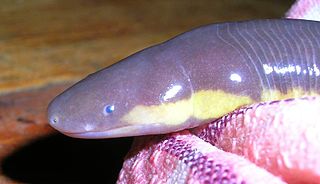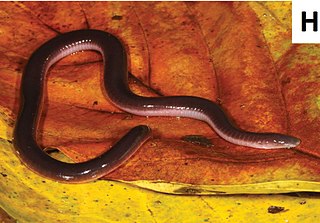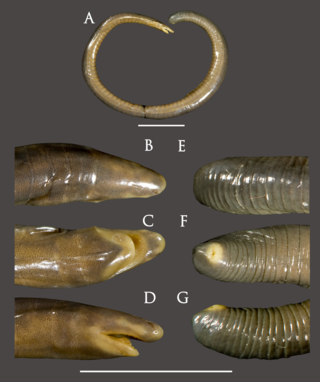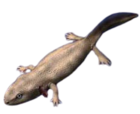
Caecilians are a group of limbless, vermiform (worm-shaped) or serpentine (snake-shaped) amphibians with small or sometimes nonexistent eyes. They mostly live hidden in soil or in streambeds, and this cryptic lifestyle renders caecilians among the least familiar amphibians. Modern caecilians live in the tropics of South and Central America, Africa, and southern Asia. Caecilians feed on small subterranean creatures such as earthworms. The body is cylindrical and often darkly coloured, and the skull is bullet-shaped and strongly built. Caecilian heads have several unique adaptations, including fused cranial and jaw bones, a two-part system of jaw muscles, and a chemosensory tentacle in front of the eye. The skin is slimy and bears ringlike markings or grooves and may contain scales.

Rhinatrematidae is a family of caecilians, also known as the Neotropical tailed caecilians, American tailed caecilians. or beaked caecilians. They are found in the equatorial countries of South America.

The Ichthyophiidae are the family of Asiatic tailed caecilians or fish caecilians found in South and Southeast Asia as well as southernmost China.

Uraeotyphlus is a genus of caecilians in the family Ichthyophiidae. There are seven species in this genus, all of which are endemic to the Western Ghats of southwestern India. Previously, the genus has also been placed in its own monotypic family Uraeotyphlidae.

The Scolecomorphidae are a family of caecilians also known as tropical caecilians, buried-eyed caecilians, or African caecilians. They are found in Cameroon in West Africa, and Malawi and Tanzania in East Africa. Caecilians are legless amphibians which superficially resemble worms or snakes.

Caeciliidae is the family of common caecilians. They are found in Central and South America. Like other caecilians, they superficially resemble worms or snakes.
Gegeneophis carnosus is a species of caecilian found in Karnataka and Kerala states, India. Its common name Periah Peak caecilian refers to its type locality, though it is also known under names blind caecilian and pink blind caecilian.
Gegeneophis danieli, the Amboli caecilian or Daniel's caecilian, is a species of caecilians in the family Indotyphlidae. It was discovered from near Amboli in Western Ghats of Maharashtra.
Gegeneophis ramaswamii, common names Tenmalai caecilian, Tenmalai blind caecilian, Ramaswami's caecilian, and forest caecilian is a species of caecilian. It is endemic to the southern portion of the Western Ghats, India, and is recorded from Kerala and Tamil Nadu. The specific name ramaswamii honours L. S. Ramaswami, an Indian herpetologist.
Indotyphlus maharashtraensis is a species of caecilians described in 2004 by scientists of Bombay Natural History Society and the Natural History Museum, London. It is only the second species of Indotyphlus known to science, and only known from its type locality near Humbarli village, Satara District, in the Western Ghats of Maharashtra, India. Common names Humbarli caecilian, Maharashtra caecilian, and Konkan tail-less caecilian have been coined for it.

The Western Ghats in India are home to several species of caecilians (Gymnophiona). Caecilians are legless, burrowing amphibians which mostly live in leaf litter, loose soil, under rocks and decaying logs. They are also found in agricultural fields and only surface during the monsoon. The body is elongated and smooth with a slimy skin. The smaller caecilians superficially resemble earthworms while the larger ones are often mistaken for snakes. However, they can be told apart from earthworms by the presence of eyes, teeth and skeleton and from snakes by the lack of scales on skin. The eyes in caecilians are not well developed which is most likely to be because of their burrowing life style. They are considered as rare which is apparently due to their subterranean habits. To see them one has to search carefully and be at the right place and at the right time. There are few places where they are common, but, at least one species was reported to be abundant in agricultural fields in Kerala. The larger caecilians can resemble snakes, but their skin is smooth, not scaly.

Microcaecilia is a genus of caecilians in the family Siphonopidae.
Uraeotyphlus oommeni, sometimes known as the Oommen's caecilian, Oommen's Uraeotyphlus, or Bonnacord caecilian, is a species of caecilian in the family Ichthyophiidae. Within Uraeotyphlus, it belongs to the U. malabaricus group showing no obvious external differentiation between primary and higher-order annuli. This species is endemic to the Western Ghats and only known from its type locality, Bonaccord, Thiruvananthapuram district, southern Kerala. Very little is known about this species known only from a single specimen collected from an imprecise location.
Indotyphlus is a small genus of caecilians in the family Grandisoniidae. As caecilians in general, they superficially resemble earthworms. The genus is endemic to the Western Ghats, India. They are sometimes known as Battersby's caecilians.

Ichthyophis davidi, the Chorla giant striped caecilian, is a new caecilian species of India discovered in Chorla, a village situated on the borders of Goa, Maharashtra, and Karnataka in the Mhadei region of India. It is one of the largest known limbless, yellow-striped caecilians from the Western Ghats. It is named in honour of David Gower, department of zoology, Natural History Museum, London, in recognition of his contributions to Indian caecilian studies. The discovery was made by researchers Gopalakrishna Bhatta of the department of biology, BASE Educational Services Private Limited, Bengaluru; K. P. Dinesh and C. Radhakrishnan of western ghats regional centre, Calicut; P. Prashanth of Agumbe Rainforest Research Station, Agumbe; and Nirmal Kulkarni of Mhadei Research Centre, Chorla Ghat.
Gegeneophis primus is a species of caecilian discovered in Wynad district in the Western Ghats of Kerala, India. The species was described in 2012 by Ramachandran Kotharambath, Mark Wilkinson, and colleagues.

Chikila is a genus of amphibian in the order Gymnophiona (caecilians). It is the only genus within the family Chikilidae. All members of the genus are known from northeast India and Bangladesh.
Nirmal Ulhas Kulkarni is a herpetologist, field ecologist, conservationist, and wildlife photographer. Director (Ecology) of Wildernest Nature Resort, an eco-tel in the Chorla Ghats (Goa), Chairman of the Mhadei Research Centre, Team Lead of Hypnale Research Station and promoter of HERPACTIVE, a study initiative on Herpetofauna. As of December 2012, he lives in Goa.

Gegeneophis mhadeiensis, commonly known as the Mahadeyi caecilian, Mhadei caecilian, or Mhadei's blind caecilian, is a species of caecilian belonging to the family Grandisoniidae. It is endemic to the Western Ghats in southern India, and is threatened by habitat loss.














